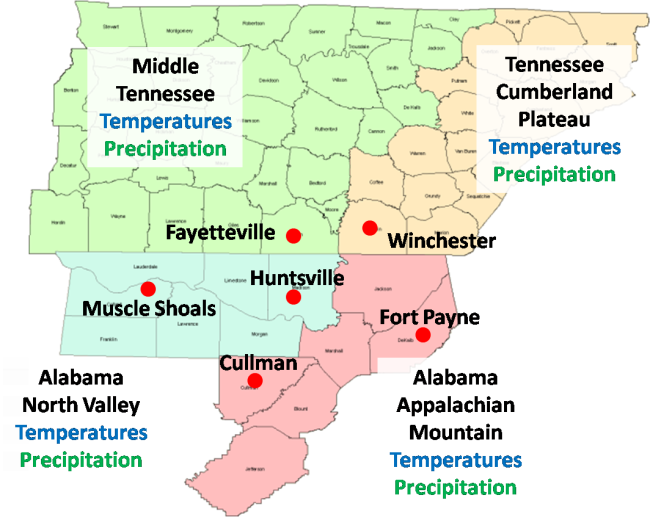El Niño conditions are continuing to evolve in the Pacific and last through the winter months, with the Climate Prediction Center predicting that this latest one will likely reach moderate strength. This large scale component of the Earth's climate system, although located in the tropical Pacific, can have impacts on our weather here in the Tennessee Valley. Granted, impacts in other parts of the world can be much more significant, with large scale changes in precipitation and temperature patterns, depending on the strength and character of the El Niño. Nevertheless, here's a look at how temperature and precipitation in our region have been affected by El Niños of the past (since 1900).
To see past effects for a particular region, click on the Temperatures or Precipitation links within the appropriate regional map.

To learn more information about El Niño, including how it is monitored, impacts to other parts of the globe, the latest updates and data, and forecast information, you may follow the links below...
The El Niño theme page from the Pacific Marine Environmental Laboratory
The El Niño Southern Oscillation (ENSO) page from the Climate Prediction Center
Notes about this project
In order to obtain a relatively large sample size, this study utilized data between the years 1900 and 2007. Sea surface temperature anomalies for the Niño 3.4 Region, since 1950, were obtained from the Climate Prediction Center, while data prior to 1950 were obtained from the National Center for Atmospheric Research. It should be noted that different statistical methods were used to determine sea surface temperature anomalies between the datasets. However, they exibited reasonable similarity in the overlapping years since 1950 for the purposes of this study.
Temperature and Precipitation data for the climate divisions were obtained from the Physical Science Division of NOAA's Earth System Research Laboratory.
The magnitude of El Niño conditions in this study are defined as following:
Neutral Conditions...a running mean (December through February) of sea surface temperature anomalies in the Niño 3.4 Region between -0.4 °C and 0.4°C
Weak El Niño...a running mean (December through February) of sea surface temperature anomalies in the Niño 3.4 Region between 0.5°C and 0.9°C
Moderate El Niño...a running mean (December through February) of sea surface temperature anomalies in the Niño 3.4 Region between 1.0°C and 1.4°C
Strong El Niño...a running mean (December through February) of sea surface temperature anomalies in the Niño 3.4 Region 1.5°C and greater
If you have any questions or comments, please feel free to send them to sr-hun.webmaster@noaa.gov.